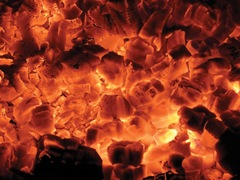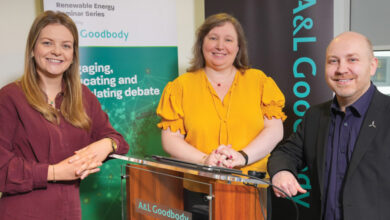 Northern Ireland spends more on heating the home than any other region in the UK. Ryan Jennings finds out why and what is being done to help the fuel-poor.
Northern Ireland spends more on heating the home than any other region in the UK. Ryan Jennings finds out why and what is being done to help the fuel-poor.
Defined as spending more than 10 per cent of a household income on heating the home, fuel poverty has moved up the agenda as more and more households have been left out in the cold.
The levers for dealing with the problem are spread out throughout the Executive. DETI has overall responsibility for energy, DSD is the welfare department and takes the lead in dealing with fuel poverty and the Housing Executive – a DSD agency – has the lead in promoting energy
efficiency for social housing.
Income, energy prices and energy efficiency all play a part in making people fuel-poor so it is perhaps unsurprising that the number of homes in fuel poverty is estimated to have increased by around 50 per cent since the last strategy was published in 2004.
‘Ending fuel poverty’ committed government to the ambitious target of ending fuel poverty in vulnerable houses and all social rented stock by this year
and for the rest of the population by 2016.
At that time 61 per cent of Housing Executive properties were fuel-poor, while those properties which were owner- occupied returned 24 per cent.
There were also worries for the private rented sector, where 48 per cent of stock was deemed to be in fuel poverty. By far the social groupings most at risk of becoming fuel-poor were the 18 to 24s (57 per cent) and those over 75 (54 per cent).
The most recent official figures on fuel poverty come from the 2006 Housing Condition Survey. It showed that around one in three (34 per cent) households were stricken in that year although with the rise in fuel prices and more people joining the dole queue, it is expected though not officially confirmed, that half of all homes here are currently in fuel poverty.
The Housing Executive’s 2009 survey has been completed but the preliminary findings only show levels of unfitness and have not yet been used to calculate the fuel poverty level.
In May 2008, MP Jo Swinson asked the then-Energy Minister Malcolm Wicks for the average household fuel costs per year of all the UK regions. The figures given by the Minister, recorded in 2006, showed that Northern Ireland spent by far the most on bills, with £1,211.10, compared to North East England, which spent the least, £750.60.
While residents of London spent £751.70 each year, that amounted to only 2.2 per cent of disposable income. In Northern Ireland that figure was 4.9 per cent.
In income terms, students are most likely to be fuel-poor but that statistic doesn’t fit the trend given that many students living away from home are supported in part by their parents. Outside that figure, people who are unemployed and those “looking after the family” are the next most likely.
The method of heating also plays a part. Those people who rely on solid fuels tend to be more fuel poor than those who heat their homes with oil or gas. Those prices, the strategy says, should be “made low and stable”.
However, since its publication, the price of crude oil has risen to over $100 per barrel – though it has decreased in recent months – with gas also experiencing a significant increase locally. Seventy-two per cent of homes in the province still use oil as the primary heating source.
Among the most vulnerable groups are the elderly, disabled people, those living with a long-term illness or a family with at least one child under 16.
There is no one specific factor which leads to the problem; the climate and lower household income in this part of the world, high energy prices and poor energy efficiency all contribute to falling into difficulties.
Locally the Consumer Council has called for a replication of the model used in Kirklees Council in Yorkshire. That
scheme, the Affordable Warmth Strategy, offers free loft and cavity wall insulation to the residents in the area.
In the last two years it has provided loft insulation for 36,134 homes and cavity wall insulation for 16,942 properties. By the Yorkshire council’s estimation, those householders have saved £200.
A DSD spokesman was keen to emphasise that fuel poverty did not solely rest at Margaret Ritchie’s door. Income and energy prices of course are out of DSD control, while its role can reasonably only be seen as one of a response team.
To date the DSD says that it has allocated £27 million to counter fuel poverty in 9,000 homes through the Warm Homes Scheme.
The winter fuel payment is paid each year to those aged over 60 (£250) and 80 (£400) while the emergency cold weather payment has been released five times between Christmas and the end of March.
Questioned on her department’s role in easing fuel poverty here, a DETI spokeswoman said its focus is on “business competitiveness”, which could
arguably lead to increased jobs and incomes in the province. However, DETI “continues to work with others on energy- related matters such as fuel poverty, on which DSD has lead responsibility.”
She said that it is working with the wider energy industry, the Utility Regulator, the Consumer Council with an aim to ease the effects of fuel poverty while the Inter- departmental Group on Fuel Poverty, which is chaired by Ritchie, meets quarterly.
Notably the department has been examining what scope there is for regulatory action in order to make tariff changes for the fuel-poor. Any introduction of ‘social tariffs’, however, would need political endorsement.
A DSD spokeswoman confirmed that the revised fuel poverty strategy is expected to be put out for consultation “soon”, complete with up-to-date statistics. It is unlikely that the target of eradicating fuel poverty by 2016 will be restated as Housing Executive evidence shows that even if all energy efficiencies were to be made, the problem would still exist.
|
Region |
Average annual fuel bill (£) |
% disposable income |
|
England |
805.00 |
2.9 |
|
Wales |
868.20 |
3.7 |
|
Scotland |
895.80 |
3.4 |
|
Northern Ireland |
1,211.10 |
4.9 |
|
UK |
826.30 |
3.0 |
Source: Hansard, 13 May 2008. Figures for 2006





